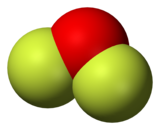Oxygen difluoride

| |

| |
| Names | |
|---|---|
| IUPAC name
Oxygen difluoride
| |
Other names
| |
| Identifiers | |
3D model (
JSmol ) |
|
| ChEBI | |
| ChemSpider | |
ECHA InfoCard
|
100.029.087 |
| EC Number |
|
PubChem CID
|
|
RTECS number
|
|
| UNII | |
CompTox Dashboard (EPA)
|
|
| |
| |
| Properties | |
| OF2 | |
| Molar mass | 53.9962 g/mol |
| Appearance | colorless gas, pale yellow liquid when condensed |
| Odor | peculiar, foul |
| Density |
|
| Melting point | −223.8 °C (−370.8 °F; 49.3 K) |
| Boiling point | −144.75 °C (−228.55 °F; 128.40 K) |
| hydrolyzes[1] slowly | |
| Vapor pressure | 48.9 atm (at −58.0 °C or −72.4 °F or 215.2 K[a]) |
| Thermochemistry | |
Heat capacity (C)
|
43.3 J/mol K |
Std molar
entropy (S⦵298) |
246.98 J/mol K |
Std enthalpy of (ΔfH⦵298)formation |
−24.5 kJ mol−1 |
Gibbs free energy (ΔfG⦵)
|
42.5 kJ/mol |
| Hazards | |
| GHS labelling:[4] | |
   
| |
| Danger | |
| H270, H280, H314, H330 | |
| NFPA 704 (fire diamond) | |
| Lethal dose or concentration (LD, LC): | |
LC50 (median concentration)
|
|
| NIOSH (US health exposure limits): | |
PEL (Permissible)
|
TWA 0.05 ppm (0.1 mg/m3)[2] |
REL (Recommended)
|
C 0.05 ppm (0.1 mg/m3)[2] |
IDLH (Immediate danger) |
0.5 ppm[2] |
| Related compounds | |
Related compounds
|
|
Except where otherwise noted, data are given for materials in their standard state (at 25 °C [77 °F], 100 kPa).
| |
Oxygen difluoride is a
oxidizer and has attracted attention in rocketry for this reason.[5] With a boiling point of −144.75 °C, OF2 is the most volatile (isolable) triatomic compound.[6] The compound is one of many known oxygen fluorides
.
Preparation
Oxygen difluoride was first reported in 1929; it was obtained by the electrolysis of molten
water.[7][8] The modern preparation entails the reaction of fluorine with a dilute aqueous solution of sodium hydroxide, with sodium fluoride
as a side-product:
- 2 F2 + 2 NaOH → OF2 + 2 NaF + H2O
Structure and bonding
It is a covalently bonded molecule with a
oxidation number of +2 for the oxygen
atom instead of its normal −2.
Reactions
Above 200 °C, OF2 decomposes to oxygen and fluorine by a radical mechanism.
- 2 OF2 → O2 + 2 F2
OF2 reacts with many metals to yield
Nonmetals also react: phosphorus reacts with OF2 to form PF5 and POF3; sulfur gives SO2 and SF4; and unusually for a noble gas, xenon reacts (at elevated temperatures) yielding XeF4
and xenon oxyfluorides.
Oxygen difluoride reacts very slowly with water to form hydrofluoric acid:
- OF2 + H2O → 2 HF + O2
It can oxidize
sulphur dioxide to sulfur trioxide and elemental fluorine
:
- OF2 + SO2 → SO3 + F2
However, in the presence of
UV radiation, the products are sulfuryl fluoride
(SO2F2) and pyrosulfuryl fluoride (S2O5F2):
- OF2 + 2 SO2 → S2O5F2
Safety
This section needs expansion. You can help by adding to it. (August 2018) |
Oxygen difluoride is considered an unsafe gas due to its oxidizing properties. Hydrofluoric acid produced by the hydrolysis of OF2 with water is highly corrosive and toxic, capable of causing necrosis, leaching calcium from the bones and causing cardiovascular damage, among a host of other highly toxic effects.
Popular culture
In
radiothermal
heating.
Notes
- critical temperature, which is below ordinary room temperature.
References
- ^ "difluorine monoxide; oxygen difluoride, physical properties, suppliers, CAS, MSDS, structure, Molecular Formula, Molecular Weight, Solubility, boiling point, melting point". www.chemyq.com.
- ^ a b c NIOSH Pocket Guide to Chemical Hazards. "#0475". National Institute for Occupational Safety and Health (NIOSH).
- ^ "Oxygen difluoride". Immediately Dangerous to Life or Health Concentrations (IDLH). National Institute for Occupational Safety and Health (NIOSH).
- ^ GHS: GESTIS 570242
- ^ "Oxygen Difluoride - an overview | ScienceDirect Topics". www.sciencedirect.com. Retrieved 2023-11-03.
- ISBN 978-0-08-037941-8.
- Comptes rendus hebdomadaires des séances de l'Académie des Sciences(in French). 188: 1253–1255. Retrieved February 21, 2013.
- Comptes rendus hebdomadaires des séances de l'Académie des Sciences(in French). 185: 652–654. Retrieved February 21, 2013.

